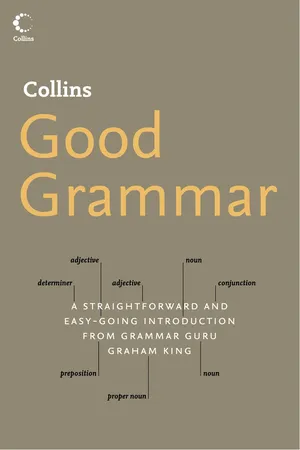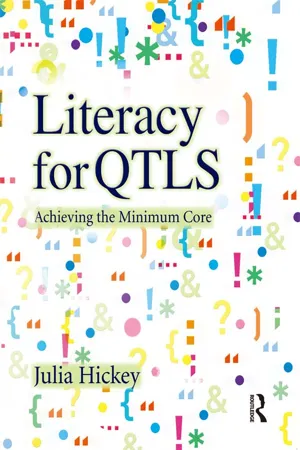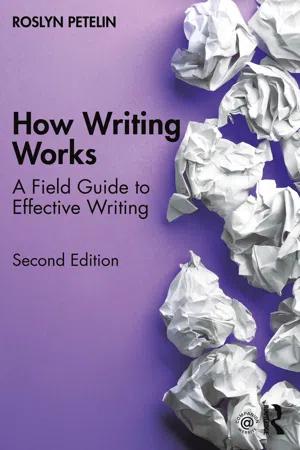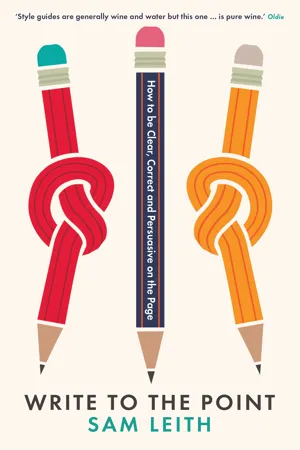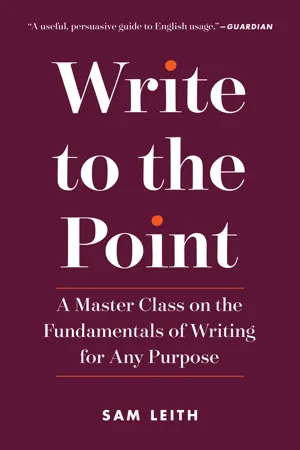Languages & Linguistics
Dashes
Dashes are punctuation marks used to indicate a sudden break or change in thought within a sentence. They can be used to set off information that is not essential to the main point of the sentence or to emphasize a particular phrase or clause. In writing, dashes can add emphasis and help to create a more conversational tone.
Written by Perlego with AI-assistance
5 Key excerpts on "Dashes"
- eBook - ePub
- Graham King(Author)
- 2014(Publication Date)
- Collins(Publisher)
Although the dash is a much maligned mark – especially by punctuation purists who decry its substitution for the colon – it has in recent times attracted a growing band of defenders. ‘It’s the most exciting and dramatic punctuation mark of them all!’ claim some.Primarily used to interrupt or extend a sentence, the dash is an extraordinarily versatile mark when used creatively. It is a bit of a larrikin with a disdain for rules and thus can be a lot of fun in the often po-faced world of punctuation. But here are some of the more respectable ways in which the dash will be found useful:LINKING DEVICEMrs Sims had four daughters – Poppy, Iris, Pansy and Petal.AS A PAUSEEveryone expected the poet to be controversial – but not to the extent of swearing at the chairwoman and falling off the stage.CUEING A SURPRISEThe adhesive gave way, the beard came adrift and Santa Claus was revealed as – Aunt Clara!NOTING AN EXCEPTIONA straight line is the shortest distance between two points – when you’re sober.INDICATING HESITATION‘There will be, of course, er– a small charge, because – well, er – ’SEPARATING LISTSShe assembled all the ingredients – flour, sugar, eggs, salt, lard and raisins – and started on the pudding.AFTERTHOUGHTSThey babbled on, delighted at sighting the rare parakeet – I didn’t see so much as a feather.Where the dash is used parenthetically – to enclose matter in much the same way as with brackets or commas – don’t forget the second dash. It’s an omission which trips many people – even the grammar authority G V Carey in his Mind The Stop (1939):No wonder that in some matters the dash has fallen into disrepute; but I still maintain that, if kept in its place – and I make one here for luck, it is a very useful stop.The sentence calls for a dash, not a comma, after luck. It’s a lesson to us all – not to be slapdash with the dash!The Hyphen
Although both are little horizontal lines – albeit one a shade shorter than the other – hyphens and Dashes are not related. A hyphen joins two or more words together, while a dash keeps them apart. What they do have in common is that they are inclined to be overused and abused. - eBook - ePub
Literacy for QTLS
Achieving the Minimum Core
- Julia Hickey(Author)
- 2013(Publication Date)
- Routledge(Publisher)
Three quarters or three-quarters are both acceptable. Be consistent. Try to avoid breaking a word at the end of a line.Dash —• The dash is used to interrupt a sentence with a phrase that doesn’t fit grammatically with the rest of the sentence. It identifies a secondary thought or additional information. It is quite informal. Learners used mind maps and flow charts – the session leant itself to the needs of learners with a visual learning preference .Checkpoints Where the interruption takes the form of a separate closely linked clause, commas should be used rather than a dash.Brackets ()• Brackets are used in a similar fashion to the dash but are a stronger indicator of the presence of additional information. The session lent itself to learners with a visual learning preference (my own learning preference is kinaesthetic) .Many writers use a pair of commas rather than brackets to show additional information within a sentence if the parenthesis is closely related to the main part of the sentence.Checkpoints The correct phrase to describe something written inside brackets is ‘in parentheses’.Make sure that if you use brackets at the end of a sentence the full stop is outside the brackets.• Quotation marks
There are two types of quotation mark – single ( ‘ ’ ) and double ( “ ” ). The other name for these marks is ‘inverted commas’. Whenever a piece of text quotes what someone else has said or written, their words should be in quotation marks, either single or double, ‘which to use depends on personal preference’ (Cullup, 1999).Direct speech records what someone says as if they were speaking. The words they use are clearly signposted by the punctuation that surrounds their words so that the speech is separate from the narrative that describes who said what, where, when and how.Indirect or reported speech This is where the writer reports, using their own words, what a speaker has said. Reported speech does not need quotation marks. Their senior manager told the assembled tutors that they had worked extremely hard in preparation for the new course - eBook - ePub
How Writing Works
A field guide to effective writing
- Roslyn Petelin(Author)
- 2021(Publication Date)
- Routledge(Publisher)
The semicolon tells you that there is still some question about the preceding full sentence; something needs to be added . . . It is almost always a greater pleasure to come across a semicolon than a full stop. The full stop tells you that is that; if you didn’t get all the meaning you wanted or expected, you got all the writer intended to parcel out and now you have to move along. But with a semicolon there you get a pleasant little feeling of expectancy; there is more to come; read on; it will get clearer.(p. 126)The second main use of the semicolon is to punctuate listed items that are internally punctuated, for example, Remember to check your grammar, especially agreement of subjects and verbs; your spelling, especially tricky words like ‘liaison’; and your punctuation, especially your use of the apostrophe.The dash
The dash splits; the hyphen joins. There are two kinds of dash, the em dash and the en dash.The em dash (—), also known as the em rule (the width of an uppercase printed M), is used, unspaced, as a pair to mark off a parenthetical element in a sentence (when the break is more abrupt than the use of commas or parentheses allows): We knew that we— even with our training—were no match for them.It can also gather up a series of thoughts by commenting on the preceding text: Style, pizzazz, superior cooking ability, a very nice holiday house, a love of cats—Cecilia’s criteria for a flatmate were extensive.And it can be used to signal an abrupt change in a sentence’s structure: Of all the flowers, I still prefer the heliconia to its showy cousin—oh, but I forgot! It’s your identical twin, Erwin, who’s the botanist!A pair of em Dashes is sometimes used to mark off a parenthetical element in a sentence. This is called a dash pair. These three books—on presenting, interviewing, and negotiating—are helpful. Never use more than two em Dashes in a sentence.The en dash (–), (the width of an uppercase printed N), is used, unspaced, in spans of figures and expressions relating to time and distance, in place of the word to: 1948–2021 - eBook - ePub
Write to the Point
How to be Clear, Correct and Persuasive on the Page
- Sam Leith(Author)
- 2017(Publication Date)
- Profile Books(Publisher)
Coming Up for Air without using a single one. But then, a little poignantly, he wrote to his publisher to boast about it because – we can presume – he was worried that nobody would notice.On the other hand the Czech writer Milan Kundera, whose side I take in this, wrote in 1988: ‘I once left a publisher for the sole reason that he tried to change my semicolons to periods.’The Dash
There are, for the ordinary user, two main sorts of dash:1. the em-bar or em-dash (which was originally the width of the letter M on a printer’s block): —2. the en-dash (which was the width of an N): –The dash, as they used to say about absinthe, rend fou .* Depending on your word-processing package, your nationality and the time of day, the rules about Dashes will vary. Em-dash and en-dash are often in free variation, with the difference that an em-dash will generally butt right up against the words next door to it and the en-dash will generally have a space on either side.Dashes can do the work of a colon, a semicolon or a comma – essentially, marking off a pause or introducing (with a bit more emphasis) the coordinator in a compound sentence. Compare:He went to the chemist, but they were out of pregnancy tests .AndHe went to the chemist – but they were out of pregnancy tests .The latter, with that slightly more dramatic pause, makes the case seem a little bit more urgent.Unlike commas or semicolons, however, they can’t be used in a limitless series.* You’ll find either one of them, or a pair, in any given sentence.Paired Dashes work to mark out parentheses or interpolations. I recognise in myself – because you end up noticing these things – an addiction to them. They seem to me to occupy a role somewhere between the comma and the bracket proper in this case: a little more swashbuckling than the bracket in terms of maintaining the conversational flow of the sentence; a little more emphatic (and, potentially, less confusing) than the comma. The material included between two Dashes is slightly more likely to be important to the meaning of the sentence than material between brackets: an addition or qualification rather than an optional extra. - eBook - ePub
Write to the Point
A Master Class on the Fundamentals of Writing for Any Purpose
- Sam Leith(Author)
- 2018(Publication Date)
- The Experiment(Publisher)
Coming Up for Air without using a single one. But then, a little poignantly, he wrote to his publisher to boast about it because—we can presume—he was worried that nobody would notice.On the other hand the Czech writer Milan Kundera, whose side I take in this, wrote in 1988: “I once left a publisher for the sole reason that he tried to change my semicolons to periods.”The Dash
There are, for the ordinary user, two main sorts of dash:1. The em bar or em dash (which was originally the width of the letter M on a printer’s block): —2. The en dash (which was the width of an N ): –The dash, as they used to say about absinthe, rend fou .* Depending on your word-processing package, your nationality, and the time of day, the rules about Dashes will vary. The em dash and en dash are often in free variation.A dash can do the work of a colon, a semicolon, or a comma—essentially, marking off a pause or introducing (with a bit more emphasis) the coordinator in a compound sentence. Compare: He went to the chemist, but they were out of pregnancy tests. He went to the chemist—but they were out of pregnancy tests. The latter, with that slightly more dramatic pause, makes the case seem a little bit more urgent.Unlike commas or semicolons, however, they can’t be used in a limitless series.* You’ll find either one of them, or a pair, in any given sentence.Paired Dashes work to mark out parentheses or interpolations. I recognize in myself—because you end up noticing these things—an addiction to them. They seem to me to occupy a role somewhere between the comma and the bracket proper in this case: a little more swashbuckling than the bracket in terms of maintaining the conversational flow of the sentence; a little more emphatic (and, potentially, less confusing) than the comma. The material included between two Dashes is slightly more likely to be important to the meaning of the sentence than material between brackets—an addition or qualification rather than an optional extra.
Index pages curate the most relevant extracts from our library of academic textbooks. They’ve been created using an in-house natural language model (NLM), each adding context and meaning to key research topics.
Explore more topic indexes
Explore more topic indexes
1 of 6
Explore more topic indexes
1 of 4
